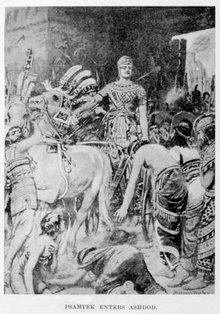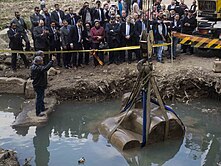Psamtik I
| Horus name | ||||||||||||||||||||
|---|---|---|---|---|---|---|---|---|---|---|---|---|---|---|---|---|---|---|---|---|
| ||||||||||||||||||||
| Nebty name | ||||||||||||||||||||
| ||||||||||||||||||||
| Golden Horus | ||||||||||||||||||||
| ||||||||||||||||||||
| Prenomen (Praenomen) | ||||||||||||||||||||
| ||||||||||||||||||||
| Nomen | ||||||||||||||||||||
| ||||||||||||||||||||
Nitocris I
Wahibre Psamtik I (Ancient Egyptian: Wꜣḥ-jb-Rꜥ Psmṯk) was the first pharaoh of the Twenty-sixth Dynasty of Egypt, the Saite period, ruling from the city of Sais in the Nile delta between 664–610 BC. He was installed by Ashurbanipal of the Neo-Assyrian Empire, against the Kushite rulers of the Twenty-fifth Dynasty, but later gained more autonomy as the Assyrian Empire declined.
Name
The Egyptian name psmṯk, pronounced as Psamāṯăk,[5] was a short form of pꜣ-sꜣ-n-mṯk, meaning "the man of Meṯek", with Meṯek presumably a deity.[6]
His name was rendered by the Assyrians as Pishamilki (Akkadian: 




 Pišamilki[7]), by the Ancient Greeks as Psammētikhos (Ψαμμητιχος), and by the Romans as Psammētichus.
Pišamilki[7]), by the Ancient Greeks as Psammētikhos (Ψαμμητιχος), and by the Romans as Psammētichus.
Psamtik was also called Nabu-shezibanni (Akkadian: 





 and
and 





 [8] Nabu-šezibanni), meaning "O Nabu, save me!"[9] by the Assyrians.
[8] Nabu-šezibanni), meaning "O Nabu, save me!"[9] by the Assyrians.
Background

In 671 BCE, the Assyrian king Esarhaddon invaded Egypt. This invasion was directed against the Kushite rulers of the Twenty-fifth Dynasty of Egypt, who had been in control of Upper Egypt, rather than against the native Egyptian rulers. The Assyrians created an administration relying on local Egyptian rulers, and put in place the twelve kinglets who formed a Dodecarchy ruling over the Nile Delta. They also formed alliances with the ruler of the city of Sais, Necho I, who was the most powerful of the Delta kinglets, as well as with Pakruru, the ruler of the important nome of Per-Sopdu.[11]
In 665 BCE, the Kushite king Tantamani invaded Lower Egypt again, and Necho I and Pakruru resisted the Kushite attack. Necho I died in battle and his son Psamtik I fled to Syria, while Pakruru became the spokesperson of the Delta kinglets during the peace negotiations with Tantamani at Memphis.[11]
The next year, in 664 BCE, the Assyrians under Esarhaddon's son Ashurbanipal invaded Egypt again, and the Assyrian army retook Memphis, proceeded with the Sack of Thebes, and expelled Tantamani from Egypt. Necho I's son Psamtik I returned to Egypt with this invading force, was installed by the Assyrians as the ruler of Sais and Memphis, and concluded with the Assyrians an adû agreement, some type of superior-inferior relation, but none of the Assyrian sources details the arrangements.[11]
Reign
For the first two years of his reign, Psamtik I ruled in conformity with the arrangement implemented by the Assyrians in Egypt as one of many vassal kinglets of the Egyptian Dodecarchy. According to Herodotus, during this period, Psamtik unwittingly fulfilled a prophecy by an oracle which promised the kingship of all Egypt to whoever poured a libation from a bronze vessel, after which the other kinglets of the Docecarchy chased him from Memphis, of which he lost the rule, and he had to flee into the swamps of the Nile Delta.[11]


After being chased from Memphis, Psamtik I received another similar prophecy from the goddess Wadjet of Buto, who promised him the rule over all Egypt should he employ bronze men from the sea. Beginning in 662 BCE, Psamtik I formed contacts with Gyges, the king of the Anatolian kingdom of Lydia, who sent to Egypt the Ionian Greek and Carian mercenaries that Psamtik I used to reconquer Memphis and defeat the other kinglets of the Dodecarchy, some of whom fled to Libya. Psamtik I might have been also aided in these military campaigns by Arabs from the Sinai Peninsula.[11]
After having eliminated all his rivals, Psamtik I reorganized these mercenaries and placed them in key garrisons at Daphnae in the East and Elephantine in the South to prevent a possible Kushite attack and to control trade.[11] This military aid from Lydia lasted until 658 BCE, at which point Gyges faced an impending Cimmerian invasion.[14] By Psamtik I's 4th regnal year, he completed the forging of an alliance with the powerful family of the Masters of Shipping from Heracleopolis, and by his 8th regnal year in 657 BCE, he was in full control of the Delta.[11]
Interpretations of Psamtik I's wars as an alliance between Sais and Lydia against Assyria appear to be inaccurate, despite negative attitudes of the Assyrians towards Gyges's and Psamtik's actions.[11] The Assyrians had risen Sais into preeminence in Egypt after expelling the Saites' Kushite enemies from the country, but Psamtik I and Ashurbanipal had signed a treaty with each other, and no hostilities between them is recorded. Thus Psamtik I and Ashurbanipal had remained allies ever since the former had been put in power with Assyrian military support. The participation of the Arab tribes of the Sinai, who were Assyrian vassals, further attest to the lack of enmity between Sais and Assyria at this period, and the silence of Assyrian sources concerning Psamtik I's expansion imply there was no hostility, whether overt or covert, between Assyria and Sais during Psamtik I's unification of Egypt under his rule.[14][11]
Likewise, Gyges's military support of Psamtik I was not directed against Assyria and is not mentioned as hostile to Assyria or allied with other countries against Assyria in Assyrian records; the Assyrian disapproval of Gyges's support for Psamtik I was primarily motivated by Gyges's refusal to form an alliance with Assyria and his undertaking of these actions independently of Assyria, which the Assyrians interpreted as an act of arrogance, rather than by the support itself.[14][11] Psamtik I's campaigns were not directed against Assyrian power and appear to have been conducted only against the rival kinglets of the Delta, and Ashurbanipal's disapproval of his actions were motivated not by his claim of kingship over Egypt, but by his revocation of the adû agreement between the two kings, as well as by Psamtik I's elimination of the other kinglets allied to Assyria, especially Pakruru of Per-Sopdu and Šarru-lū-dāri, since Ashurbanipal was aware that he had to rely on those kinglets to maintain Assyrian power in Egypt.[11]
In Psamtik I's 9th regnal year, in 656 BCE, he sent an expedition to the city of Thebes which compelled the existing God's Wife of Amun, Shepenupet II, daughter of the former Kushite Pharaoh Piye, to adopt his daughter Nitocris I as her heiress in the so-called Adoption Stela. This was concluded with the approval of the Theban aristocracy and the tacit support of Mentuemhat, who was the Fourth Priest of Amun and the Mayor of Thebes. Psamtik I had unified all of Egypt under his rule.[11]
In 655 and 654 BCE, that is his 10th and 11th regnal years, Psamtik I carried out a war with Libyan tribes who had seized control of the area from the Oxyrhynchite nome around the Bahr Yussef till the Mediterranean Sea, and who had been joined by Psamtik I's previously defeated enemies from his wars in the Delta. Following the successful conclusion of this war, Psamtik I placed an Egyptian garrison at Marea to prevent incursions by Libyans from the desert. Thus, by the end of his first decade of rule in 654 BCE, Psamtik I was firmly in control of all Egypt.[11]
According to Herodotus, Psamtik carried out a twenty-nine year siege of Ashdod.[15] The exact dating of this siege is uncertain.[16]
In the later part of Psamtik I's reign, the Neo-Assyrian Empire started unravelling following the death of Ashurbanipal in 627 BC, leaving a power vacuum in the Levant which allowed the Assyrians' former Scythian vassals to overrun the area. Some time between 623 and 616 BCE, the Scythians reached as far south as Judah and Edom until Psamtik I met them and convinced them to turn back by offering them gifts.[16]
Following the encounter with the Scythians, Psamtik expanded his military operations through the Via Maris into the Levant to support the collapsing Assyrian Empire against the Medes, Babylonians, Scythians and Chaldeans who had revolted against it. Psamtik I's intervention implied that an alliance had already been concluded between him and the Neo-Assyrian Empire, although it is unknown whether it was a new alliance between him and the new Assyrian king Sin-shar-ishkun or a renewal of the old alliance signed when Psamtik I had been enthroned by the Assyrian army as king of Sais in 664 BCE.[16]
Psamtik died in 610 BCE and was succeeded by his son, Necho II.
Investigation into the origin of language

The Greek historian Herodotus conveyed an anecdote about Psamtik in the second volume of his Histories (2.2). During his visit to Egypt, Herodotus heard that Psammetichus ("Psamṯik") sought to discover the origin of language by conducting an experiment with two children. Allegedly he gave two newborn babies to a shepherd, with the instructions that no one should speak to them, but that the shepherd should feed and care for them while listening to determine their first words. The hypothesis was that the first word would be uttered in the root language of all people. When one of the children cried "βεκός" (bekós) with outstretched arms, the shepherd reported this to Psammetichus, who concluded that the word was Phrygian because that was the sound of the Phrygian word for "bread". Thus, they concluded that the Phrygians were an older people than the Egyptians, and that Phrygian was the original language of men. There are no other extant sources to verify this story.[17]
Wives
Psamtik's chief wife was Mehytenweskhet, the daughter of Harsiese, the vizier of the North and High Priest of Re at Heliopolis. Psamtik and Mehytenweskhet were the parents of Necho II, Merneith, and the Divine Adoratrice Nitocris I.[18]
Psamtik's father-in-law—the aforementioned Harsiese—was married twice: to Sheta, with whom he had a daughter named Naneferheres, and to an unknown woman, by whom he had both Djedkare, who succeeded him as vizier of the North, and Mehytenweskhet.[19]
Discovery of a colossal statue of Psamtik I
On 9 March 2017, Egyptian and German archaeologists discovered a colossal statue about 7.9 metres (26 ft) in height at the Heliopolis site in Cairo. Made of quartzite, the statue was found in a fragmentary state, with the bust, the lower part of the head and the crown submerged in groundwater.[22]
It has been confirmed to be of Psamtik I due to engravings found that mentioned one of the pharaoh's names on the base of the statue.[23][24][25][26][27]
A spokesperson at the time commented that "If it does belong to this king, then it is the largest statue of the Late Period that was ever discovered in Egypt."[28][29] The head and torso are expected to be moved to the Grand Egyptian Museum.[22]
The statue (colossus) was sculpted in the ancient classical style of 2000 BC, establishing a resurgence to the greatness and prosperity of the classical period of old, and reconstructions bear a strong similarity with a statue of a striding Senusret I (1971-1926 BC), now in the Cairo Museum.[30][31] However, from the many gathered fragments (now 6,400 of them) of quartzite collected, it has also been established that the colossus was at some time deliberately destroyed. Certain discolored & cracked rock fragments show evidence of having been heated to high temperatures then shattered (with cold water), a typical way of destroying ancient colossi.[32]
Gallery
-
 Psamtik I kneeling, Louvre Museum
Psamtik I kneeling, Louvre Museum -
 Relief of Psamtik I making an offering to Ra-Horakhty (Tomb of Pabasa)
Relief of Psamtik I making an offering to Ra-Horakhty (Tomb of Pabasa) -
 Slab of Psamtik I. The king kneels and makes offerings to fearsome-looking deities, including a double-headed bull god and a snake. From Alexandria; originally from the temple of Atum at Heliopolis, Egypt. British Museum
Slab of Psamtik I. The king kneels and makes offerings to fearsome-looking deities, including a double-headed bull god and a snake. From Alexandria; originally from the temple of Atum at Heliopolis, Egypt. British Museum
References
- ^ "Psamtek I Wahibre". Digitalegypt.ucl.ac.uk. Archived from the original on 2 December 2011. Retrieved 20 November 2011.
- ^ Peter Clayton, Chronicle of the Pharaohs, Thames and Hudson, 1994. p.195
- ^ Eichler, Ernst (1995). Namenforschung / Name Studies / Les noms propres. 1. Halbband. Walter de Gruyter. p. 847. ISBN 3110203421.
- ^ "Psamtik I". Touregypt.net. Archived from the original on 22 November 2011. Retrieved 20 November 2011.
- ^ Ray, J. D. (1990). "The names Psammetichus and Takheta". The Journal of Egyptian Archaeology. 76: 196–199. doi:10.2307/3822031. JSTOR 3822031. Retrieved 19 August 2022.
- ^ Spiegelberg, Wilhelm (1905). "Die Namen Psammetich und Inaros". Orientalistische Literaturzeitung. 8: 559–562. Retrieved 22 September 2022.
- ^ "Pišamilki [PSAMMETICHUS I, PHARAOH OF EGYPT] (RN)". Open Richly Annotated Cuneiform Corpus. University of Pennsylvania., but the target ORACC page is corrupted. Ashurbanipal Cylinder A iii 28, Ranke, Hermann (1910). "Keilschriftliches Material zum altägyptischen Vokalisation". Abhandlungen der königlich preußischen Akademie der Wissenschaftern, historisch-philologische Klasse. 1910, Abhandlungen nicht zur Akademie gehöriger Gelehrter (Abh. II): 1–96. Retrieved 21 January 2023., p. 32
- ^ "Nabu-šezibanni [PSAMMETICHUS OF SAIS, SON OF NECHO] (RN)". Open Richly Annotated Cuneiform Corpus. University of Pennsylvania.
- ^ Dalley, Stephanie (2001). Abusch, Tzvi; Noyes, Carol; Hallo, William W.; Winter, Irene J. (eds.). Proceedings of the XLV Rencontre Assyriologique Internationale: Historiography in the Cuneiform World. Vol. 1. Bethesda, Maryland: CDL Press. p. 159. ISBN 978-1-883-05367-3.
- ^ "Wall panel; relief British Museum". The British Museum.
- ^ a b c d e f g h i j k l m Spalinger, Anthony (1976). "Psammetichus, King of Egypt: I". Journal of the American Research Center in Egypt. 13: 133–147. doi:10.2307/40001126. JSTOR 40001126. Retrieved 2 November 2021.
- ^ Keesling, Catherine M. (2017). Early Greek Portraiture. Cambridge University Press. p. 116. ISBN 978-1-107-16223-5.
- ^ Smith, Tyler Jo; Plantzos, Dimitris (2018). A Companion to Greek Art. John Wiley & Sons. p. 294. ISBN 978-1-119-26681-5.
- ^ a b c Spalinger, Anthony J. (1978). "The Date of the Death of Gyges and Its Historical Implications". Journal of the American Oriental Society. 98 (4): 400–409. doi:10.2307/599752. JSTOR 599752. Retrieved 25 October 2021.
- ^ Herodotus, The Histories, section 157
- ^ a b c Spalinger, Anthony (1978). "Psammetichus, King of Egypt: II". Journal of the American Research Center in Egypt. 15: 49–57. doi:10.2307/40000130. JSTOR 40000130. Retrieved 2 November 2021.
- ^ Herodotus, "2.2.3", Histories, Internet Classics Archive, retrieved 18 March 2017.
- ^ Dodson, Aidan and Hilton, Dyan. The Complete Royal Families of Ancient Egypt. Thames & Hudson. 2004. ISBN 0-500-05128-3
- ^ Payraudeau F. Harsiésis, Un Vizir Oublié de L’Époque Libyenne. The Journal of Egyptian Archaeology. 2003;89(1):199-205. doi:10.1177/030751330308900110
- ^ Magazine, Smithsonian; Trevino, Julissa. "4,500 Newly Discovered Fragments Help Piece Together Massive Psamtik I Statue". Smithsonian Magazine., including a video featuring an analysis of the remains by Egyptologist Chris Naunton.
- ^ Lewis, Nell. "Colossal statue of 'forgotten' pharaoh brought to life in 3D images". CNN.
- ^ a b "Massive Statue of Ancient Egyptian Pharaoh Found in City Slum". National Geographic. 10 March 2017. Archived from the original on 11 March 2017. Retrieved 12 March 2017.
- ^ Youssef, Nour (17 March 2017). "So Many Pharaohs: A Possible Case of Mistaken Identity in Cairo". The New York Times. Archived from the original on 18 March 2017. Retrieved 18 March 2017.
- ^ Thompson, Ben (18 March 2017). "Two pharaohs, one statue: A tale of mistaken identity?". Christian Science Monitor. Archived from the original on 18 March 2017. Retrieved 18 March 2017.
- ^ "Egypt Pharaoh statue 'not Ramses II but different ruler'". BBC News. 16 March 2017. Archived from the original on 18 March 2017. Retrieved 18 March 2017.
- ^ "Inscription reveals colossus unearthed in Cairo slum not of Ramses II, more likely Pharaoh Psamtek I". Australian Broadcasting Corporation. 16 March 2017. Archived from the original on 17 March 2017. Retrieved 18 March 2017.
- ^ Bel Trew (17 March 2017). "Statue found in Cairo may be biggest ever from the Late Period". The Times. Archived from the original on 17 March 2017. Retrieved 18 March 2017.
- ^ "Egypt Pharaoh statue 'not Ramses II but different ruler". BBC News. 16 March 2017. Archived from the original on 16 March 2017. Retrieved 16 March 2017.
- ^ Hendawi, Hamza. "Recently discovered Egyptian statue is not Ramses II". CTVNews. Archived from the original on 16 March 2017. Retrieved 17 March 2017.
- ^ Magazine, Smithsonian; Trevino, Julissa. "4,500 Newly Discovered Fragments Help Piece Together Massive Psamtik I Statue". Smithsonian Magazine., see video featuring an analysis of the remains by Egyptologist Chris Naunton.
- ^ Lewis, Nell. "Colossal statue of 'forgotten' pharaoh brought to life in 3D images". CNN.
- ^ Connor, Simon (1 January 2019). "Ashmawy, Aiman, Simon Connor, and Dietrich Raue 2019. Psamtik I in Heliopolis. Egyptian Archaeology 55, 34-39". Egyptian Archaeology: 38–39.
Bibliography
 This article incorporates text from a publication now in the public domain: Chisholm, Hugh, ed. (1911). "Psammetichus". Encyclopædia Britannica (11th ed.). Cambridge University Press.
This article incorporates text from a publication now in the public domain: Chisholm, Hugh, ed. (1911). "Psammetichus". Encyclopædia Britannica (11th ed.). Cambridge University Press.
Further reading
- Dodson, Aidan (2012). Afterglow of Empire: Egypt from the Fall of the New Kingdom to the Saite Renaissance. Oxford University Press. ISBN 978-9774165313.
- Breasted, James Henry (1906). Ancient Records of Egypt: Historical Documents from the Earliest Times to the Persian Conquest. Ancient Records, Second Series. Vol. IV. Chicago: University of Chicago Press. LCCN 06005480.
- Morkot, Robert (2003). Historical Dictionary of Ancient Egyptian Warfare. Scarecrow Press. pp. 173–174. ISBN 0810848627.
- Spalinger, Anthony (1976). Psammetichus, King of Egypt: I. New York: Journal of the American Research Center in Egypt. pp. 133–147. OCLC 83844336.
External links

- "Psamtik I". Encyclopedia Britannica. 23 October 2008. Retrieved 18 March 2017.
- "Bust from Statue of a King". Met Museum. Retrieved 18 March 2017.
- v
- t
- e
| |||||||||||||||||||||||||||||||||||
| |||||||||||||||||||||||||||
| |||||||||||||||||||||||||
Roman Period (30 BC–313 AD) | |||||||||
|---|---|---|---|---|---|---|---|---|---|
| |||||||||
Dynastic genealogies | |
|---|---|























































